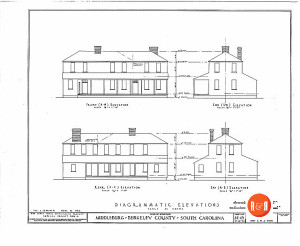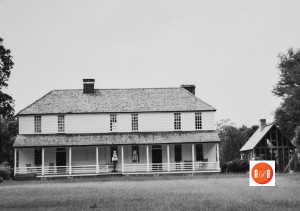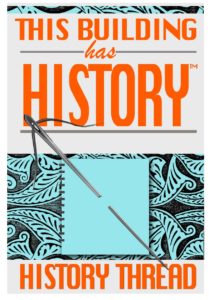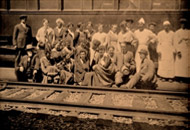“A S.C. Landmark of true importance….”
City Directories and History: The Cooper River Historic District, which is a 30,020-acre section of the region centered along both branches of the Cooper River, is a remarkably intact historic and cultural landscape. In the mid-eighteenth century, the Cooper River served not only as a principal transportation route for plantation

HABS Drawings of Middleburg Plantation

Courtesy of the S.C. Dept. of Archives and History
goods, services and people, but also played a vital role in the successful production of rice. In the nineteenth and early twentieth centuries most of the plantations in the district were acquired by wealthy Northerners looking for a warmer climate in which they could create hunting preserves for their own pleasure and leisure-time activities. These new owners left their mark on the landscape by building stately new residences but they also played an important role in preserving the earlier landscape. Many historic buildings, structures, and objects from the eighteenth, nineteenth, and twentieth centuries are still standing, and archaeological remains of settlements, machines, barns, and other structures that supported agricultural activity are generally intact. In addition, landscape features such as rice fields, banks, canals, dams, reservoirs or reserves, causeways, roads, avenues, upland fields, fence lines, and cemeteries – many of them present on eighteenth and early nineteenth century plats and maps – can be seen on the ground today. Numerous outbuildings are also included with several of the properties. Listed in the National Register February 5, 2003. [Courtesy of the SC Dept. of Archives and History]
Click here for additional information on this property as shown in the National Register Nomination.
The earliest mention of Benjamin Simons on record was found in the issue of a warrant on July 15, 1697, which proposed to lay out to him 100 acres of land in Berkeley County, but no grant appears on the record at that time. The earliest grant to him seems to be dated May 5, 1704, for 350 acres and from its description this grant covers a great portion of Middleburg.
There seems to be some disagreement here as to dates, but it must be that Middleburg was built on the issuance of the warrant in 1697 for the 100 acres, and that the grant came later, as an old Simons record states that “Anne the fifth child was born at 6 in the evening in Middleburg house in 1699. ” This plantation is said to have been given its name by Esther Dupre Simons, wife of the first Benjamin, after a city in Zeeland, where her family had refugeed.
The third Benjamin Simons married “Little Mistress Chicken,” a stepdaughter of Elias Ball, and the little girl who was tied to a tombstone in Strawberry Chapel graveyard in Childsbury. Middleburg came into the hands of the Ball family when it was bought by John Coming Ball in 1872. Interestingly enough his wife was Anne Simons.
(Information from: Names in South Carolina by C.H. Neuffer, Published by the S.C. Dept. of English, USC)
Stay Connected
Explore history, houses, and stories across S.C. Your membership provides you with updates on regional topics, information on historic research, preservation, and monthly feature articles. But remember R&R wants to hear from you and assist in preserving your own family genealogy and memorabilia.
Visit the Southern Queries – Forum to receive assistance in answering questions, discuss genealogy, and enjoy exploring preservation topics with other members. Also listed are several history and genealogical researchers for hire.
User comments welcome — post at the bottom of this page.
Please enjoy this structure and all those listed in Roots and Recall. But remember each is private property. So view them from a distance or from a public area such as the sidewalk or public road.
Do you have information to share and preserve? Family, school, church, or other older photos and stories are welcome. Send them digitally through the “Share Your Story” link, so they too might be posted on Roots and Recall.
Thanks!



